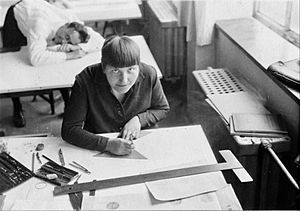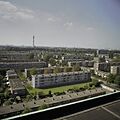Lotte Stam-Beese facts for kids
Quick facts for kids
Lotte Beese
|
|
|---|---|

Lotte Beese and Helmut Schulze at the Tracing Table. c. 1928.
|
|
| Born |
Charlotte Ida Anna Beese
28 January 1903 Reisicht, Germany (now Rokitki, Poland)
|
| Died | 18 November 1988 (aged 85) Krimpen aan den IJssel, Netherlands
|
| Nationality | German / Dutch |
| Alma mater | Bauhaus school, Dessau |
| Occupation | Architect |
Lotte Beese (born Charlotte Ida Anna Beese) was a German-Dutch architect, photographer, and city planner. She was born on January 28, 1903, and passed away on November 18, 1988. Lotte Beese played a very important role in rebuilding the city of Rotterdam in the Netherlands after it was heavily bombed during World War II.
Contents
A Look at Lotte Beese's Life
Lotte Beese was born in a place called Reisicht, Germany (which is now Rokitki, Poland). When she was young, she first worked as a weaver, making fabrics.
Early Career as a Photographer
Before becoming an architect, Lotte Beese was a talented photographer. She worked as a professional photographer for a short time, from 1926 to 1930. Even in this short period, her work was very important. Today, her photographs are kept in famous museums. These include the Museum of Modern Art in New York and the J. Paul Getty Museum.
Studying at the Bauhaus School
From 1926 to 1928, Lotte Beese attended the famous Bauhaus school in Dessau, Germany. At Bauhaus, she learned from well-known artists and designers. Some of her teachers were Josef Albers, Wassily Kandinsky, and Gunta Stölzl.
She first planned to study weaving, which was seen as a more "feminine" subject. However, she later became the first woman to be accepted into the architecture program at Bauhaus Dessau. She studied architecture with Hannes Meyer, who was the director of the school. Meyer was more open to women studying subjects that were usually for men.
Working in Different Countries
After leaving Bauhaus in 1928, Lotte Beese worked in several cities. She worked in offices in Berlin, Moscow, Ukraine, Brno, and Amsterdam.
In Moscow, she met Mart Stam, a Dutch architect. They later married and moved to the Netherlands in 1934. In Amsterdam, they started their own architecture firm called Stam en Beese Architecten.
Lotte Beese had not finished her diploma at Bauhaus. This made it harder for her to work as an architect in the Netherlands. So, in 1940, at age 37, she started studying architecture again at VHBO in Amsterdam. She graduated in 1945.
Rebuilding Rotterdam
From 1946 to 1968, Lotte Beese worked for the Agency for Urban Development and Reconstruction of Rotterdam. This agency was in charge of rebuilding the city after it was badly damaged during World War II. She started as an urban-planning architect and later became the chief architect. She was one of the few women who made such a big difference in the city's reconstruction.
Lotte Beese's Architectural Work
Lotte Beese designed many social housing areas around Rotterdam. She used a style called Functionalist, which focused on practical design. Her work was also influenced by the ideas of the CIAM group.
Some of the housing districts she worked on include:
- Kleinpolder (1946–1952)
- Pendrecht (1948–1952)
- Westpunt in Hoogvliet (1956–1957)
- Het Lage Land (1961–1962)
- Alexanderpolder/Ommoord (1957–1971)
Ideas for City Planning
Lotte Beese's most important contribution was her plan for Pendrecht. She used ideas like the 'neighborhood concept' and 'cluster' in her design.
The Neighborhood Concept
The 'neighborhood concept' meant that a neighborhood should be like a small, self-sufficient city. It would have its own social structure and feel like a village. This idea was used a lot after the war to create strong communities.
The Cluster Idea
The 'cluster' was a way to organize spaces. It created a physical and social link between each home and the larger neighborhood. Beese also introduced a smaller unit called the 'stamp'. This 'stamp' was like a tiny version of the bigger community.
Each 'stamp' was designed for different types of residents. For example, there were designs for families, single people, and older adults. The way buildings were placed, with different heights, also showed this social mix. Shopping centers, schools, and churches were spread out in the neighborhoods. Some streets were even free of traffic.
Beese designed communal gardens and green areas between buildings. She hoped that people from different 'stamps' would meet and interact in these open spaces. She believed that having different types of people in a small area would create an open and democratic society. It would also make the neighborhood feel close-knit. However, over time, some of these ideas were changed or removed.
Images for kids
See also
 In Spanish: Lotte Beese para niños
In Spanish: Lotte Beese para niños



